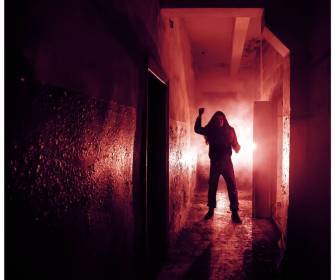How To Write A Psychological Thriller Without Frying Your Own Brain

Whether you’re a fan of the genre or looking to try your hand at writing one, a psychological thriller can be fun to both read AND write. But what goes into making these stories so captivating?
A psychological thriller is a story that combines elements of suspense, mystery, and even horror to create an unsettling and often terrifying experience for the reader. These stories typically revolve around characters who are dealing with some kind of mental or emotional disturbance, which leads them to behave in erratic or dangerous ways.
I’ve written six such novels, with a seventh out next year in 2024. Here are my top tips …
1) Start With an Intriguing Premise
Your story should start with a bang! Draw your readers in with an enticing and mysterious premise. Ask yourself what dark secrets your characters are hiding, or what could drive someone to commit a crime.
In my psychological thriller Never Have I Ever, it starts with my protagonist receiving an anonymous note. It reads: ‘Never have I ever … been punished for what I have done.’ But what could THAT be about?? Eeek!
2) Create Believable CharactersPsychological thrillers center around characters who are often flawed and damaged, which can make them difficult to create.��Pay attention to their backstories, motivations, and needs so you can make them fully fleshed-out individuals.
It’s important to ensure that your characters feel real and relatable, even if they’re not always likeable. (Remember, female characters are often accused of being ‘unlikeable’ anyway, no matter what they do! I call this the ‘female burden’).
3) A Compelling ProtagonistA compelling protagonist is particularly important in this genre. It’s important to choose someone readers can empathize with and root for throughout the novel.
Create a detailed character sketch of your main character, including their motivation for solving the mystery or problem at hand. (Lots of writers struggle with characterization, so I’ve created a free masterclass on creating characters which you can grab HERE).
4) Intriguing Secondary CharactersIn addition to a well-developed protagonist, your story will also need believable and interesting secondary characters. These characters should contribute to the plot in a meaningful way, without taking away from the mystery itself.
Since secondary characters should HELP or HINDER the protagonist, I always recommend putting your secondary characters on ‘team protag’ or ‘team antag’. This way, you can be sure secondaries are pulling their weight in the story.
5) Build Suspense SlowlyA successful psychological thriller takes its time in ramping up the suspense and tension. Keep your readers guessing by slowly revealing information about your characters and their pasts, while also raising the stakes as the story progresses.
Avoid rushing things … a slow burn really is key in this genre! Make sure you study structure and plotting archetypes so you can make the most of tension and suspense.
I always recommend the book The Seven Basic Plots by Christopher Booker for this, but there’s plenty of helpful resources to help you – including this site, Writing Helping Writers!
6) A Richly Described Setting
The setting of your story is just as important as the characters populating it. Choose a location that is rich in history and detail, then use vivid descriptions to bring it to life for readers.
In my books, I frequently write about seaside towns out of season. This is because my characters are often outsiders, cut off from others. If you’ve ever been in such a place in winter, you will know seaside towns are often shut down and cut off during the winter months. This is an example of the storyworld reflecting the characters’ lives and dilemmas.
7) Choose Your Ending VERY CarefullyThe ending of a psychological thriller is especially important���it should be both climactic and satisfying without being too predictable or pat. Twist endings can be particularly effective in this genre, so long as they make sense within the context of the story as a whole.
Never, ever, ever fly in an ending out of the ‘left field’. Sometimes it can help to START with your ending and plot backwards to ‘find’ the beginning when it comes to twists.
Editing, Polishing and Setting Your Story FreeEditing, polishing and setting your story free are all important aspects of writing a psychological thriller. It is important to keep your readers engaged by making sure your story is well-written and edited.
There are many ways to edit your story, but it is important to take your time and do it right. Here are some tips for editing, polishing and setting your story free:
1) Take Your Time!Don’t rush through the editing process. Once you have written your first draft, put it away for a few days or weeks before you start editing. This will give you some distance from the material and allow you to come back with fresh eyes.
2) Be RuthlessWhen you are editing, be ruthless in cutting out anything that doesn’t move the story forward or add anything new. Get rid of any unnecessary details or scenes that drag on too long.
3) Make Sure Everything Makes SenseAs you are editing, make sure that everything in the story makes sense. Check for any plot holes or inconsistencies and fix them before moving on.
4) Pay Attention to DialogueDialogue is an important part of any story, but it is especially important in a psychological thriller. Make sure that each character’s dialogue sounds natural and believable. Listen for any awkward phrases or stiffness in the dialogue and revise accordingly.
5) Let Others Read ItI know it’s scary, but you need others’ opinions and suggestions on your work. I always recommend going as far as you can with honing your craft, peer review, or writers’ group critiques BEFORE you pay for notes or feedback though. There’s no point paying to get feedback on the basics, get your money’s worth!
Good Luck! One Stop for Writers
One Stop for Writers is here to help!
Check out these powerful tools that help you create believable characters, including the largest show-don’t-tell descriptive database that fleshes out motivations, negative traits, emotions, settings, and many other items in this post.
Get 25% off any plan until September 22!
The post How To Write A Psychological Thriller Without Frying Your Own Brain appeared first on WRITERS HELPING WRITERS��.
Writers Helping Writers
- Angela Ackerman's profile
- 1022 followers



